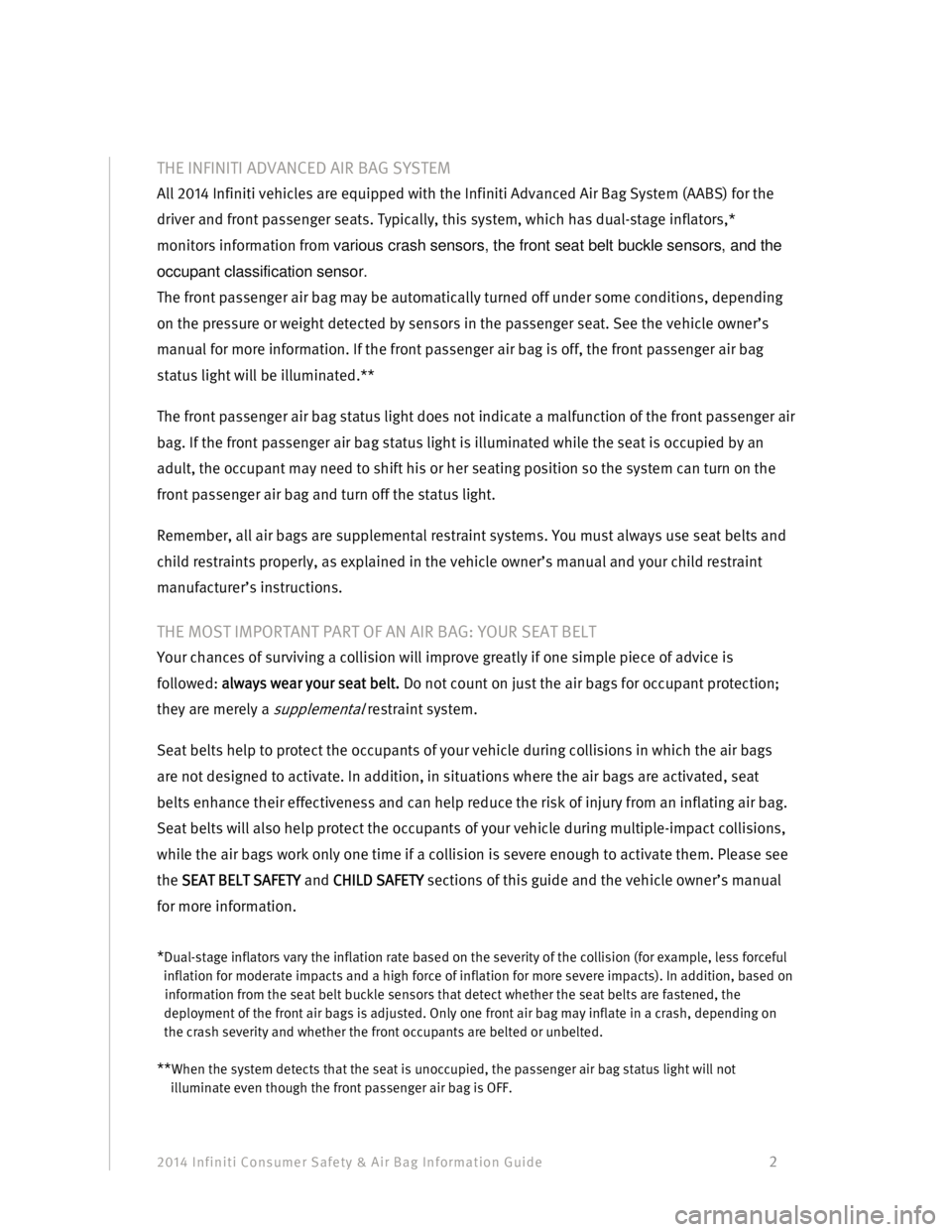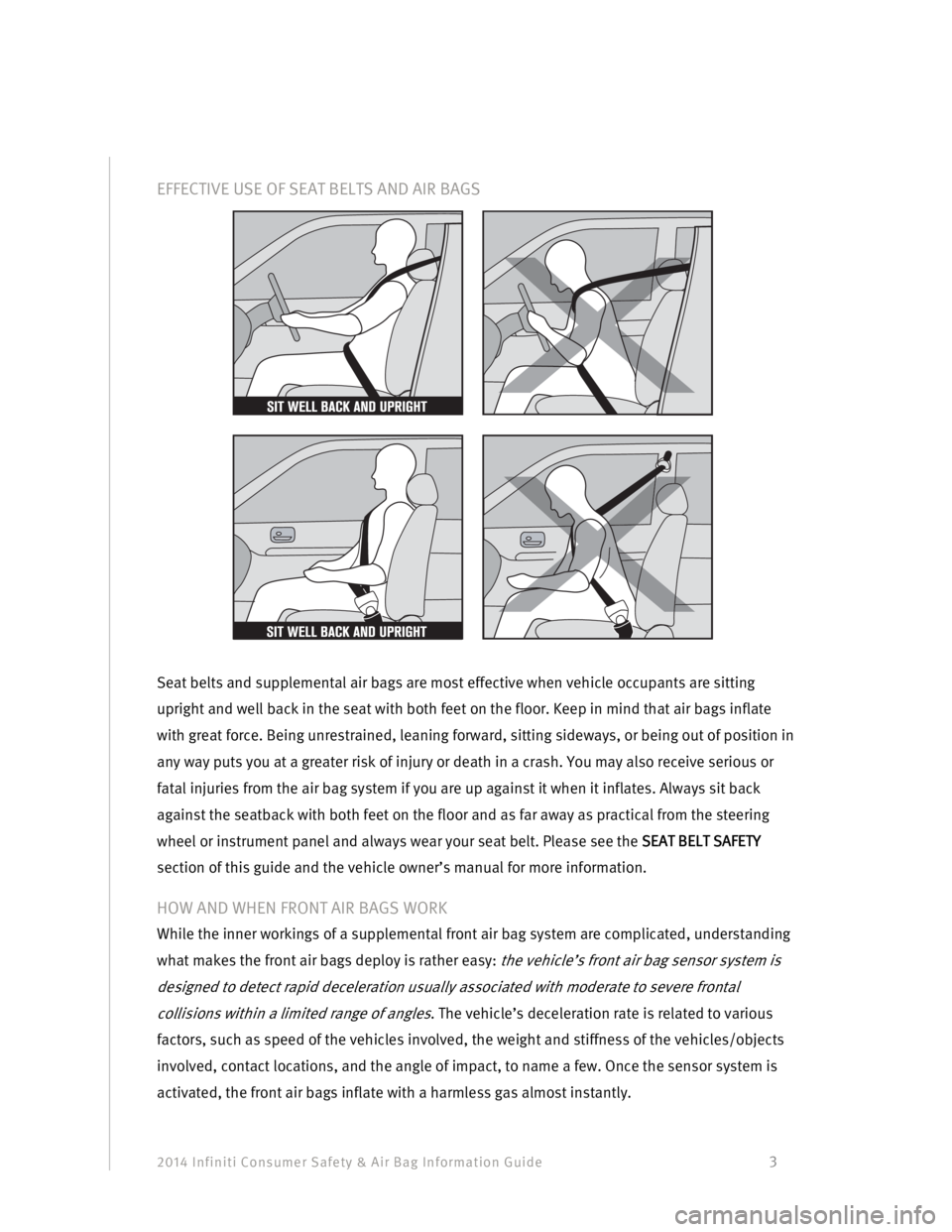sensor INFINITI QX60 2014 Consumer Safety And Air Bag Information Guide
[x] Cancel search | Manufacturer: INFINITI, Model Year: 2014, Model line: QX60, Model: INFINITI QX60 2014Pages: 18, PDF Size: 0.47 MB
Page 3 of 18

2014 Infiniti Consumer Safety & Air Bag Information Guide 2
THE INFINITI ADVANCED AIR BAG SYSTEM
All 2014 Infiniti vehicles are equipped with the Infiniti Advanced Air Bag System (AABS) for the
driver and front passenger seats. Typically, this system, which has dual-stage inflators,*
monitors information from various crash sensors, the front seat belt buckle sensors, and the
occupant classification sensor.
The front passenger air bag may be automatically turned off under some conditions, depending
on the pressure or weight detected by sensors in the passenger seat. See the vehicle owner’s
manual for more information. If the front passenger air bag is off, the front passenger air bag
status light will be illuminated.**
The front passenger air bag status light does not indicate a malfunction of the front passenger air
bag. If the front passenger air bag status light is illuminated while the seat is occupied by an
adult, the occupant may need to shift his or her seating position so the system can turn on the
front passenger air bag and turn off the status light.
Remember, all air bags are supplemental restraint systems. You must always use seat belts and
child restraints properly, as explained in the vehicle owner’s manual and your child restraint
manufacturer’s instructions.
THE MOST IMPORTANT PART OF AN AIR BAG: YOUR SEAT BELT
Your chances of surviving a collision will improve greatly if one simple piece of advice is
followed: always wear your seat belt. Do not count on just the air bags for occupant protection;
they are merely a
supplemental restraint system.
Seat belts help to protect the occupants of your vehicle during collisions in which the air bags
are not designed to activate. In addition, in situations where the air bags are activated, seat
belts enhance their effectiveness and can help reduce the risk of injury from an inflating air bag.
Seat belts will also help protect the occupants of your vehicle during multiple-impact collisions,
while the air bags work only one time if a collision is severe enough to activate them. Please see
the SEAT BELT SAFETY and CHILD SAFETY sections of this guide and the vehicle owner’s manual
for more information.
*Dual-stage inflators vary the inflation rate based on the severity of the collision (for example, less forceful
inflation for moderate impacts and a high force of inflation for more severe impacts). In addition, based on
information from the seat belt buckle sensors that detect whether the seat belts are fastened, the
deployment of the front air bags is adjusted. Only one front air bag may inflate in a crash, depending on
the crash severity and whether the front occupants are belted or unbelted.
**
When the system detects that the seat is unoccupied, the passenger air bag status light will not
illuminate even though the front passenger air bag is OFF.
Page 4 of 18

2014 Infiniti Consumer Safety & Air Bag Information Guide 3
EFFECTIVE USE OF SEAT BELTS AND AIR BAGS
Seat belts and supplemental air bags are most effective when vehicle occupants are sitting
upright and well back in the seat with both feet on the floor. Keep in mind that air bags inflate
with great force. Being unrestrained, leaning forward, sitting sideways, or being out of position in
any way puts you at a greater risk of injury or death in a crash. You may also receive serious or
fatal injuries from the air bag system if you are up against it when it inflates. Always sit back
against the seatback with both feet on the floor and as far away as practical from the steering
wheel or instrument panel and always wear your seat belt. Please see the SEAT BELT SAFETY
section of this guide and the vehicle owner’s manual for more information.
HOW AND WHEN FRONT AIR BAGS WORK
While the inner workings of a supplemental front air bag system are complicated, understanding
what makes the front air bags deploy is rather easy:
the vehicle’s front air bag sensor system is
designed to detect rapid deceleration usually associated with moderate to severe frontal
collisions within a limited range of angles
. The vehicle’s deceleration rate is related to various
factors, such as speed of the vehicles involved, the weight and stiffness of the vehicles/objects
involved, contact locations, and the angle of impact, to name a few. Once the sensor system is
activated, the front air bags inflate with a harmless gas almost instantly.